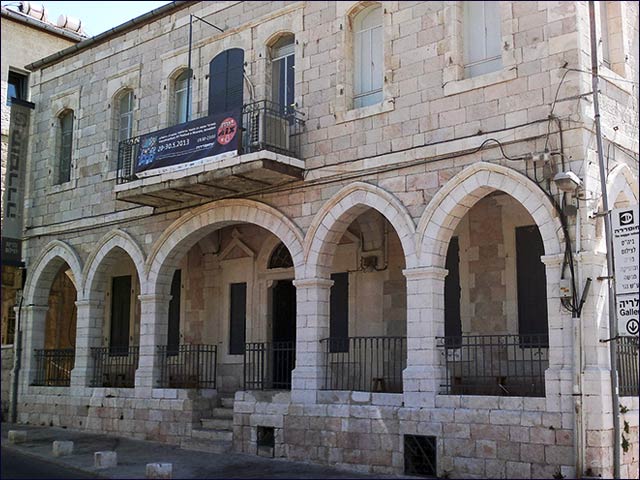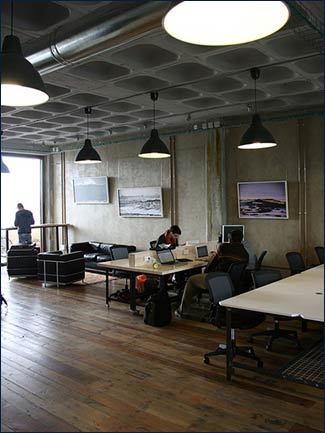By Avigayil Kadesh
They’ve nicknamed it “Jerus-art-lem” -- a vibrant community of young artists who are trying to return Israel’s capital to its halcyon days as a center for cutting-edge art and culture.
According to leaders of the non-profit
Ruach Chadasha (New Spirit) organization, more than half of Israel’s art students are enrolled at any given time in the city’s various visual and performing arts academies, only to move to the Tel Aviv area as they begin their careers. New Spirit has made it a priority to encourage many of these talented graduates to keep the city as their home base.
“A lot of young artists come to study here. Most of them leave Jerusalem right after finishing their studies,” says
Emmanuel Witzthum, a cultural entrepreneur involved in New Spirit’s Young Artists program and specifically its Toolbox Project, where mentors teach art school graduates professional career management skills.
 An exhibition of student work at the Naggar School
An exhibition of student work at the Naggar School Artistic flight from Jerusalem was not always the case. Witzthum points out that the capital city has most of the country’s schools of higher education in the arts, such as the renowned Bezalel Academy of Arts and Design, the Jerusalem Academy of Music and Dance, the Sam Spiegel Film and Television School,
Ma'aleh School of Television, Film & the Arts and Jerusalem Studio School, among many others.
“In the 1970s and 1980s, Jerusalem experienced a flowering, with a lot of alternative art and music. And then they gradually began to leave,” says Witzthum. “Over the past several years, Jerusalem has experienced a rebirth.”
Keeping both talented artists and young families local has been a major emphasis in Mayor Nir Barkat’s agenda for the city. In addition to the Israel Festival, Israel’s biggest performing arts festival, public spaces have been enhanced by the Jerusalem Season of Culture and projects such as Contact Point, a night-long event that transforms the Israel Museum into an accessible hub for creativity.
“There are a lot of independent artists and small clusters of organizations, such as one that locates abandoned houses and produces festivals at these houses,” Witzthum says.
The Hansen Compound, a former hospital, now hosts artistic events, and the Mahane Yehuda market got a facelift in the form of a street art project. The Old City is the setting for myriad arts and music festivals throughout the year, open to the public for free.
This renaissance in some ways mirrors the revitalization of Jerusalem’s historic neighborhoods, and in other ways acts as a catalyst for such revitalization.
MusraraMix
For the past 13 years the
MusraraMix Festival has been staged in the streets and courtyards of the Musrara (Morasha) neighborhood that between 1948 and 1967 housed poor North African Jewish immigrants. Today the old stone edifices house an eclectic mix of descendants of original residents, wealthy newcomers and large ultra-Orthodox families.

The Naggar School of Photography in Musrara
is closely entwined with the neighborhood.
MusraraMix targets people who do not ordinarily go to galleries or museums, says Avi Dabach of the Naggar School of Photography, New Media, New Music, Visual Communication and Photo-Therapy.
“The art goes out from the school and the people of the neighborhood host us outdoors. Thousands of people come for one of the nicest art events in Jerusalem, three days and three nights for free,” says Dabach.
Naggar was established 26 years ago in the basement of a former Musrara school building, and now uses the entire structure in addition to a gallery and production facilities in the refurbished Musrara Community Center nearby, which also houses the Machol Shalem dance troupe.
Dabach directs the Musrara Collection, a project to visually document family stories and photos gathered from the neighborhood. He showed visitors an animated short narrated by an old-time resident who was arrested and jailed by the British Mandate government at age nine for stealing scrap metal. In the 1970s, the subject of the film helped found Musrara’s Black Panthers, an influential Israeli movement dedicated to social and economic justice.
Artists in the Neighborhoods
“There are a lot of initiatives in Israel’s periphery for young creative people, but we believe that Jerusalem, unlike some of those other cities, can be a real alternative to Tel Aviv,” says New Spirit CEO Elisheva Mazia.
Upon co-founding New Spirit in 2003, she saw a need to bolster Jerusalem’s artistic culture as a magnet for young singles and families. “Eventually, it doesn’t matter if you have the best job,” she says. “The issue of culture brings people to the city.”
At first, she partnered with local cultural institutions and consumers of culture. A few years ago, she began working directly with creators of culture as well.
“New Spirit is concentrating on empowering these young artists and encouraging them to contribute to our focus neighborhoods. They cannot be involved if they don’t have an income, so each has a mentor and [financial] help in getting established,” Mazia says.
The organization introduces them to directors of institutions and festivals, and to each other. “We’re creating a scene,” she explains.
In one of the focus neighborhoods, Gonenim (also called the Katamonim), Inbal Dekel shows visitors inside Pandora Studio, a renovated old bomb shelter.
Here, newly graduated professional puppeteers use the space to create and rehearse performances for adults. One major venue for their craft is the yearly
International Puppet Theater Festival at Jerusalem’s Train Theater every summer, but they do more localized shows as well.
“With the help of New Spirit [and the UJA Federation of New York], we got a place here in Gonenim in a barter arrangement,” Dekel says. “In exchange for the studio space, three times a year we do something for the neighborhood -- for example, puppetry and juggling workshops. This way, little by little, we form a relationship with the neighborhood.”
Dekel notes that, although many different non-profits run programs in disadvantaged neighborhoods, “not a lot of groups are doing something to encourage young families to stay and create communities here.”
Blending business with art
Cooperative startup work environments are still more abundant in Tel Aviv than in Jerusalem, but this is changing in an effort to attract and keep budding businesspeople in the capital.
One of the few Jerusalem co-working spaces,
PICO (People, Ideas, Community, Opportunities), aims to bolster both creativity and entrepreneurship in Jerusalem. The partners who founded this private venture in January 2013 engaged a local company, Shahar Katsav Design Studio, to turn an industrial warehouse into an inviting space for entrepreneurs and artistic exhibitions.

PICO’s co-working space is also an art gallery“From a very dark, dingy space we’ve created a space where artists can hang their works,” says co-founder Isaac Hassan. “We wanted to be at the heart of the industrial part of Jerusalem in perhaps one of the ugliest buildings in Jerusalem and we also wanted to respect where we were, so we decided to keep part of what it was. We kept the walls and ceiling as they were and it actually works in a grungy, design-y sort of way.”
Much thought went into issues such as lighting and how to allow for frequently changing exhibitions without making holes in the wall. The solution was to stretch picture-frame wire across the lengths of PICO’s walls from which paintings can easily be hung and removed.
Hassan says industrial design, and particularly “green” design, is an important emphasis at PICO, from its construction to the entrepreneurs it mentors. The wood conference table at PICO was made by a Greek Orthodox carpenter from trees in the Bethlehem area, a city that can be seen from the windows facing south. The communal kitchen incorporates wood that the carpenter repurposed from an old church.
In cooperation with New Spirit, PICO offers an entrepreneurship skills course for graphic designers and is working on programming to advance female entrepreneurs in fields including the arts.
“We believe that graduates of schools like Bezalel and Shenkar [School of Engineering and Design in Tel Aviv], probably among the best arts institutions in the world, don’t have to move to the center of the country because we can create an ecosystem for them to stay in Jerusalem,” says Hassan, showing off a crucifix necklace made by a PICO-mentored business called
Wear My Prayer, which incorporates an actual flower that re-blooms when sprinkled with water. “A lot of these graduates leave not because they want to, but because of a mistaken perception that they have to.”
PICO also runs once-a-week course for children ages 10-15 about entrepreneurship and creativity. “We brought a 3D printer in and they were very excited about creating things with it,” says Hassan. “We set them a task of taking apart a computer and rebuilding it. We want to give that excitement to kids. When you give them the tools to imagine what they want to create, it’s amazing what they come up with.”
Hassan and his business partner, serial entrepreneur and venture capitalist Elie Wurtman, each runs his own business affairs from the PICO work space so that they are available as mentors.
“As a co-working space, we are not just about filling the space with people and mentoring them, but about the philosophy,” Hassan says. “We are passionate about Jerusalem and we want the next generation to have the infrastructure and tools to be able to be entrepreneurs in Jerusalem as well.”